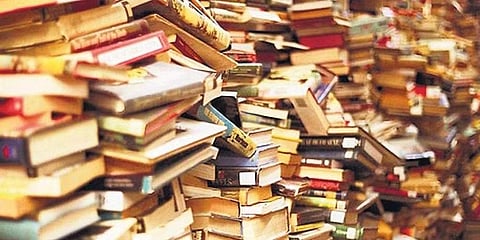
- LIFESTYLE
- FASHION
- FOOD
- ENTERTAINMENT
- EVENTS
- CULTURE
- VIDEOS
- WEB STORIES
- GALLERIES
- GADGETS
- CAR & BIKE
- SOCIETY
- TRAVEL
- NORTH EAST
- INDULGE CONNECT

Cataloguing is the last stage of book madness. After they lay their hands on a rare piece, collectors often lose interest in it. Also, they would have so many books that they would invariably postpone the herculean task of cataloguing them. Eventually, they reach a point where they become obliged to catalogue just to know what they have in their collection and start reading some of it!
Cataloguing rare books is a tedious process. You need to list not only the book’s title, author, publisher, and physical characteristics but also its provenance, condition, context, unique aspects, reason for buying, and so on. Now there are numerous apps like MyLibrary and Libib which automatically upload many of the details. You should also be aware of the many terms used in the rare book world (you can find them in the American Bookseller Association website).
George Shaw
It took me 20 years of collecting before I decided to catalogue 100 of my rarest signed books. I carefully arranged them, took pictures, and made notes about each book, and after detailed documentation, looked for a good designer. Here I was inspired by the catalogue by Graham Shaw and John Randall, From Conversion to Subversion – 250 years of printed books in India. Of course, my catalogue mentions no prices since it is not for commercial use, unlike the catalogues of booksellers and auction houses.
The first published catalogue was an auction catalogue in English from 1676, when the books of a clergyman named Lazarus Seaman were sold at a public auction in England. In the olden days, booksellers would send their latest catalogues by post; these were usually just handwritten or mimeographed sheets of paper. An interested buyer or collector would send a telegram to the bookshop, quoting the catalogue number of the item of their choice.
After the telephone was invented, collectors would rush to call the bookshop after spotting something in the catalogue they badly wanted, and whoever got the bookshop on the line first would be the lucky buyer. These days, catalogues are sent by email, although the bigger bookshops and sellers still take pride in issuing expensive hard copies with colour photos and illustrations.
Catalogues often reflect the personality of the bookseller – some are scholarly, some are witty, some are shoddy, and some are too long. Some catalogues have actually set trends, becoming the first catalogue to assemble a certain category of books not previously collected or gathered together in a single catalogue. The most famous example is Printing and the Mind of Man, where the most influential books in the world, books that changed the thinking of human beings over the course of centuries, were exhibited and brought together in their first editions. The exhibition was held in 1963 and the catalogue was published in 1967; it largely contained valuable first editions of great scientific books from the collection of Ian Fleming, who pioneered the collecting of first editions of landmark scientific publications.
Some catalogues have also been spoof catalogues! The catalogue from The Caveat Bookshop listed fictional books – books that have never existed, with made-up titles, fooling people into believing they were actually printed. Equally fascinating is the Fortsas Hoax where in 19th century France a catalogue was issued of books that were entirely made up for an auction that never took place – much to the annoyance and disappointment of the collectors who had gathered there!
Cataloguing your library is not just about keeping track of your books, but also about the memories and the stories attached to them.